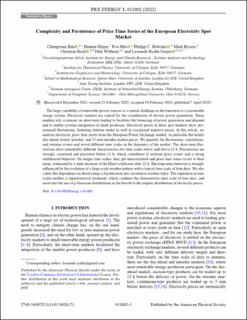| dc.contributor.author | Han, Chengyuan | |
| dc.contributor.author | Hilger, Hannes | |
| dc.contributor.author | Mix, Eva | |
| dc.contributor.author | Böttcher, Philipp | |
| dc.contributor.author | Reyers, Mark | |
| dc.contributor.author | Beck, Christian | |
| dc.contributor.author | Witthaut, Dirk | |
| dc.contributor.author | Rydin Gorjao, Leonardo | |
| dc.date.accessioned | 2022-08-31T08:10:55Z | |
| dc.date.available | 2022-08-31T08:10:55Z | |
| dc.date.created | 2022-05-11T16:27:13Z | |
| dc.date.issued | 2022-04-07 | |
| dc.identifier.issn | 2768-5608 | |
| dc.identifier.uri | https://hdl.handle.net/11250/3014617 | |
| dc.description.abstract | The large variability of renewable power sources is a central challenge in the transition to a sustainable energy system. Electricity markets are central for the coordination of electric power generation. These markets rely evermore on short-term trading to facilitate the balancing of power generation and demand and to enable systems integration of small producers. Electricity prices in these spot markets show pronounced fluctuations, featuring extreme peaks as well as occasional negative prices. In this article, we analyze electricity price time series from the European Power Exchange market, in particular the hourly day-ahead, hourly intraday, and 15-min intraday market prices. We quantify the fluctuations, correlations, and extreme events and reveal different time scales in the dynamics of the market. The short-term fluctuations show remarkably different characteristics for time scales below and above 12 h. Fluctuations are strongly correlated and persistent below 12 h, which contributes to extreme price events and a strong multifractal behavior. On longer time scales, they get anticorrelated and price time series revert to their mean, witnessed by a stark decrease of the Hurst coefficient after 12 h. The long-term behavior is strongly influenced by the evolution of a large-scale weather pattern with a typical time scale of four days. We elucidate this dependence in detail using a classification into circulation weather types. The separation in time scales enables a superstatistical treatment, which confirms the characteristic time scale of four days, and motivates the use of q-Gaussian distributions as the best fit to the empiric distribution of electricity prices. | en_US |
| dc.language.iso | eng | en_US |
| dc.publisher | American Physical Society | en_US |
| dc.relation.ispartofseries | PRX Energy;Vol. 1, Iss. 1 — April - June 2022 | |
| dc.relation.uri | https://journals.aps.org/prxenergy/pdf/10.1103/PRXEnergy.1.013002 | |
| dc.rights | Navngivelse 4.0 Internasjonal | * |
| dc.rights.uri | http://creativecommons.org/licenses/by/4.0/deed.no | * |
| dc.subject | Renewable power sources | en_US |
| dc.subject | Electricity markets | en_US |
| dc.subject | Price time series | en_US |
| dc.subject | Electricity prices | en_US |
| dc.subject | Spot markets | en_US |
| dc.title | Complexity and Persistence of Price Time Series of the European Electricity Spot Market | en_US |
| dc.type | Peer reviewed | en_US |
| dc.type | Journal article | en_US |
| dc.description.version | publishedVersion | en_US |
| dc.source.articlenumber | 013002 | en_US |
| cristin.ispublished | true | |
| cristin.fulltext | original | |
| dc.identifier.doi | https://doi.org/10.1103/PRXEnergy.1.013002 | |
| dc.identifier.cristin | 2023698 | |
| dc.source.journal | PRX Energy | en_US |
| dc.source.volume | 1 | en_US |
| dc.source.issue | 1 | en_US |
| dc.source.pagenumber | 1-17 | en_US |

